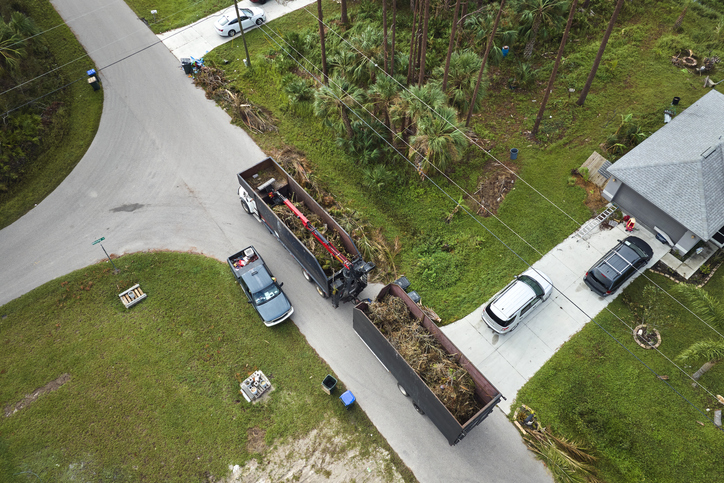
Emergency Storm Response
Tree removal plays a critical role in emergency storm response, particularly when high winds, flooding, or other severe weather events cause trees to fall or become hazardous. During such events, prompt and safe tree removal is essential to restoring power, ensuring public safety, and preventing further damage to infrastructure. This essay will explore the importance of tree removal in storm response, the processes involved, safety considerations, and the environmental impact of such actions.
Importance of Tree Removal in Emergency Storm Response
Storms, especially those of high intensity such as hurricanes, tornadoes, or severe thunderstorms, can cause trees to fall or lose branches, blocking roadways, downing power lines, and posing significant risks to public safety. Emergency storm response teams must act swiftly to address these hazards and facilitate the recovery process. Tree removal is an essential aspect of this response for several key reasons:
- Clearing Roads and Highways: Fallen trees can block critical transportation routes, hampering access for emergency vehicles, first responders, and residents needing to evacuate or receive assistance. Clearing trees from roadways is one of the first tasks for emergency responders to ensure mobility and facilitate evacuation and recovery efforts.
- Restoring Power: One of the most common storm-related incidents is the downing of power lines by fallen trees. These downed trees can leave large areas without power, creating unsafe living conditions for residents. Utility companies, in collaboration with emergency storm response teams, must quickly remove trees and debris to repair power lines and restore electricity.
- Preventing Further Damage: In some cases, trees that remain standing after a storm may be weakened or unstable, posing an ongoing hazard. Emergency teams often remove these trees preemptively to prevent them from falling in the future, potentially damaging property, vehicles, or infrastructure.
- Ensuring Public Safety: Storms can also cause trees to become hazardous even when they are still standing. Broken branches or leaning trunks are risks that must be assessed and dealt with to avoid accidents and injuries. Tree removal is often necessary to mitigate these dangers.
The Tree Removal Process in Emergency Storm Response
The process of removing trees during an emergency storm response must be efficient, safe, and carefully managed to address the immediate needs of the community. This process typically involves the following steps:
- Assessment of Damage: After the storm passes, teams conduct a thorough assessment of the area to identify hazardous trees. This includes evaluating the stability of trees that have fallen, those leaning dangerously, and trees that have suffered significant damage to their roots or trunks. The assessment is critical for prioritizing which trees need to be removed first based on their immediate threat to safety, infrastructure, or access.
- Clearing and Removal: Once the most hazardous trees have been identified, specialized equipment, such as chainsaws, cranes, and bulldozers, are used to safely remove the trees. Tree removal professionals, often including arborists and utility line workers, are trained to handle dangerous situations and ensure that trees are safely felled or trimmed without causing further damage.
- Debris Removal: After trees are removed, the remaining debris, including branches, stumps, and trunks, must be cleared. This is often done by chipping, grinding, or hauling away the debris. Effective debris removal is essential for clearing access to roads, utilities, and other critical areas.
- Repairing Infrastructure: After the trees are removed and debris cleared, emergency teams work to restore infrastructure. This can include repairing damaged power lines, traffic signals, and public services. Tree removal, while important in its own right, is part of a larger effort to return the affected area to a state of normalcy.
Safety Considerations in Tree Removal
The process of tree removal during an emergency storm response can be dangerous, especially when working with fallen trees or those that are partially damaged. As such, safety is a primary concern throughout the operation. Several safety considerations must be addressed:
- Risk Assessment and Training: Emergency storm response teams must be properly trained in tree removal techniques and safety protocols. Workers must understand how to assess the risk of tree removal, identify dangerous conditions, and operate machinery safely. They must also be able to recognize signs of instability in trees and understand the best methods for felling them without causing further hazards.
- Protective Equipment: Workers involved in tree removal must wear appropriate protective gear, including hard hats, eye protection, high-visibility clothing, gloves, and safety boots. Chainsaw operators must use chaps and other protective equipment to minimize injury risks. In high-risk situations, additional safety measures, such as ropes and harnesses for climbing, may also be necessary.
- Coordination with Other Emergency Services: Tree removal cannot occur in isolation during storm response. Teams must coordinate with other emergency services, such as fire departments, police, and utility companies, to ensure that tree removal is carried out in a safe and controlled manner. For instance, tree removal may need to be delayed until power lines are de-energized to prevent electrocution.
- Environmental Hazards: Fallen trees may pose other environmental hazards, such as blocking water flow and contributing to flooding. Care must be taken to ensure that tree removal does not create new risks, such as erosion or water contamination.
Environmental Impact of Tree Removal
While tree removal is essential for storm response, it is not without environmental consequences. The removal of trees can have a range of impacts on local ecosystems, and emergency response teams must balance the immediate need for safety with the long-term health of the environment. Some of the environmental considerations include:
- Loss of Habitat: Trees are vital habitats for a wide range of wildlife, and their removal can displace birds, insects, and other animals. While the immediate concern is safety, efforts should be made to minimize habitat loss by removing only the trees that pose a direct hazard.
- Soil Erosion: The removal of trees, especially those near riverbanks or slopes, can lead to increased soil erosion. Tree roots play a crucial role in holding soil together, and without them, areas may become more vulnerable to landslides and flooding. Emergency teams should consider erosion control measures, such as planting new vegetation or reinforcing the soil with other means, to mitigate this risk.
- Carbon Sequestration: Trees act as carbon sinks, absorbing carbon dioxide from the atmosphere. Removing trees during a storm response can contribute to the release of stored carbon, exacerbating climate change. However, this environmental impact is often secondary to the immediate need to ensure safety and restore infrastructure. In some cases, efforts may be made to recycle tree debris or use it for bioenergy, which can help offset some of the carbon emissions.
- Reforestation and Recovery: After the immediate crisis is over, replanting trees and restoring damaged ecosystems is a key part of the recovery process. This can help to rebuild habitats, prevent soil erosion, and re-establish carbon sinks. Community involvement in reforestation efforts can also help foster a sense of resilience and environmental stewardship.
Conclusion
Tree removal is a critical component of emergency storm response. It plays an essential role in clearing roads, restoring power, preventing further damage, and ensuring public safety. The process of removing trees involves careful assessment, the use of specialized equipment, and collaboration between emergency responders, arborists, and utility workers. Safety is a top priority during this process, as tree removal can be hazardous for both workers and the community. Additionally, while tree removal is necessary for immediate recovery, its environmental impact must be considered, with efforts made to minimize habitat destruction, soil erosion, and carbon emissions. Finally, after the immediate storm response, reforestation and ecosystem recovery are crucial steps in restoring the environment to its natural state. By balancing the need for safety and recovery with environmental considerations, tree removal can effectively contribute to storm response efforts while fostering long-term resilience.
